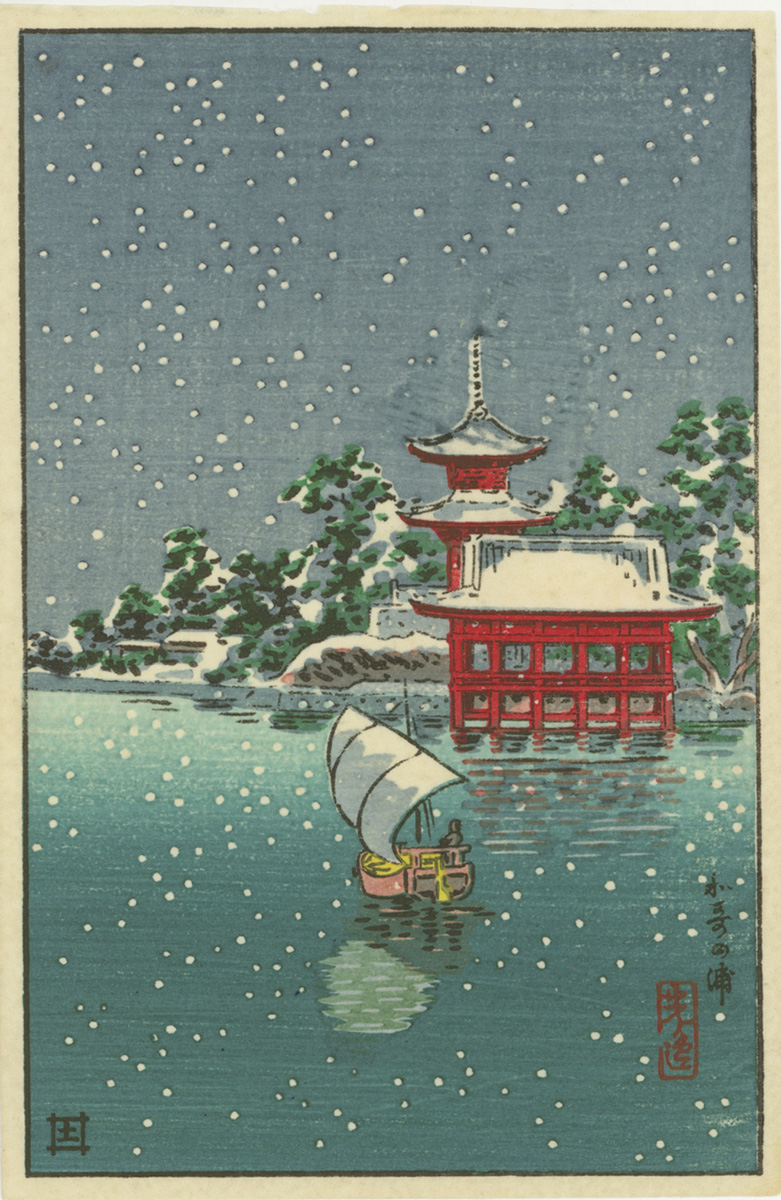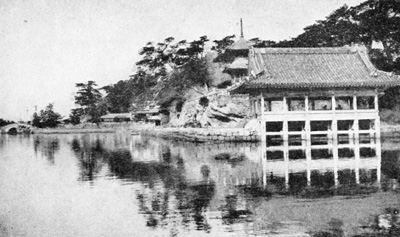About This Print
A beautiful small (postcard-size) print picturing a ferryboat on its way to, or passing by, Kankaikaku (Kankai Pavilion or, literally, sea viewing pavilion) which sits across from the Kimii-dera temple complex and its Tahōtō (two-story pagoda).
Kankaikaku and Kimiidera Tahōtō
Kankainkaku 観海閣 is a wooden pavilion built on the water by Yorinobu, the first feudal lord of the House of Tokugawa.
Source: Wakayama City Tourist Association http://www.wakayamakanko.com/eng/sightseeing/history8.html
If you stride across the blue stone of the Sandanbashi Bridge, you come to the small island of Imoseyama. If you turn around, the Kankaikaku appears floating on the sea and you feel as if you would be able to write a whole volume of poems in this place. This Kankaikaku was built as a wooden pavilion on top of the water by Yorinobu in the Keian years (1648 – 1652) and it faces Kimiidera on the other coast. (The original structure was washed away in the 2nd Murodo Typhoon in 1961. The current building is a concrete re-construction.) The reflection of Mt. Nagusa ripples in the wind in the mirror-like surface of the water and looks like it could disappear at any moment. If you gaze out over the sea at the ebb tide, you can see countless crabs swarming underneath the shrine and you are filled with love for life which has remained unchanged.
Kimii-dera tahōtō (護国院多宝塔) is one of the holiest temples belonging to the Shingon sect of Buddhism. Shingon was founded in 770 A.D. by Ikō, a Chinese priest from the Tan Dynasty. On its grounds sits Tahōtō, a kind of pagoda that is unique to temples of the Shingon tradition, which has been named an Important Cultural Property.
Print Details
| IHL Catalog | #658 |
| Title | Wakanoura 和歌の浦 |
| Series | |
| Artist | Tsuchiya Kōitsu (1870-1949) |
| Signature |  |
| Seal | see Signature above |
| Publication Date | Koitsu.com website notes: "An example of this print was taken from an album of postcards (many dated) compiled around 1934/35 belonging to a family who fled Japan in 1941. Thus is it reasonably safe to say that this scene was first published pre-war." |
| Edition | unknown |
| Publisher |  Doi 土井 seal [Marks: pub. ref. 038; seal not shown] Marks notes: Doi Sadaichi was originally a dealer in woodblock prints. He left to San Francisco, and when he returned opened a woodblock print publishing business in Tokyo. He died in 1945 and his son Eiichi (1917-1996) took over the business [changing the name to Doi Hangaten 土井版画店] which is still operating today. |
| Carver | unknown |
| Printer | unknown |
| Impression | excellent |
| Colors | excellent |
| Condition | good - paper imperfection in area of pagoda |
| Miscellaneous | |
| Genre | shin hanga (new prints) |
| Format | postcard |
| H x W Paper | 5 3/4 x 3 13/16 in. (14.6 x 9.7 cm) |
| H x W Image | 5 9/16 x 3 9/16 x in. (14.1 x 9 cm) |
| Collections This Print | |
| Reference Literature | The Catalogue Raisonne of Tsuchiya Koitsu Meiji to Shin-Hanga, Watercolours to Woodblocks, Ross F. Walker and Toshikazu Doi, Ohmi Gallery Publishing, 2009; Koitsu.com site reference TK-DH-131 |
7/28/2019



